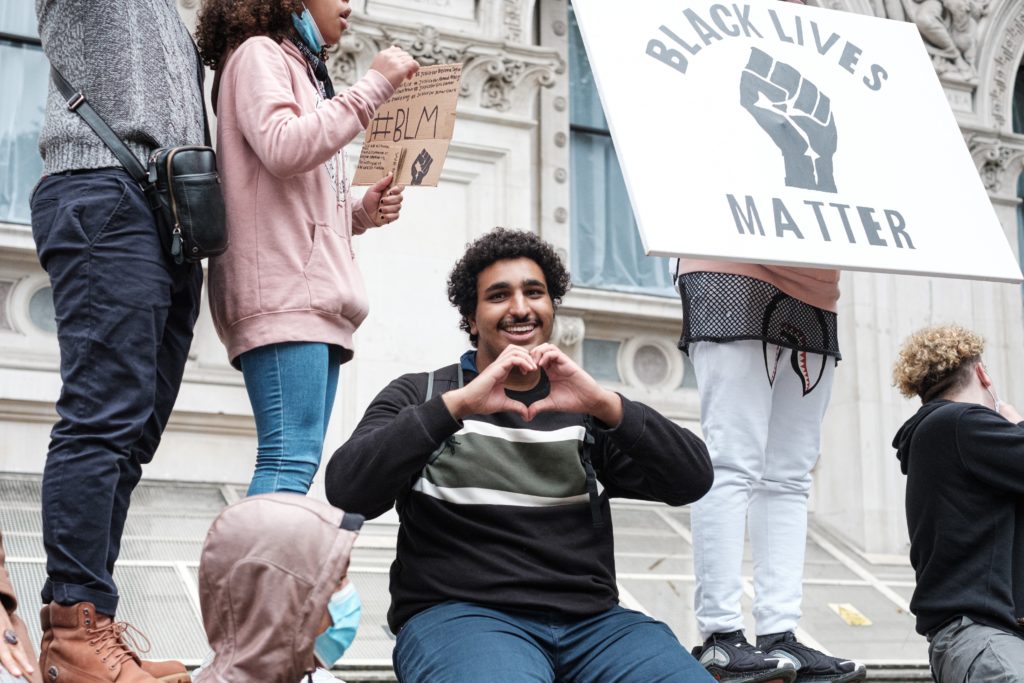
The #BlackLivesMatter human rights movement arose on social media in 2013 after the killer of 17-year-old Trayvon Martin was acquitted in Florida. It gained exposure in the street demonstrations that followed the 2014 deaths of Michael Brown in Ferguson, MO, and Eric Garner in NYC, both at the hands of police officers. Black Lives Matter, or #BLM, has since then expanded to an international movement seeking societal reforms around a host of issues, including an end to the prison-industrial complex that so egregiously and disproportionately affects black and brown communities in the US.*
But the spirit of #BLM did not begin in 2013. Nor did it begin in 1968, nor in 1865, nor even in August of 1619 when the first 20 enslaved Africans were brought across the Atlantic Ocean to the English colony of Virginia. To be sure, there is a 400+ year history of systemic racism in the United States that is a scourge on our country’s ability to truly live by its highest ideals of freedom and justice. And we must return to that history, learn from its difficult truths, and use our collective anger to dismantle the powers of white supremacy that still echo loudly today. But the spirit of #BLM did not begin in 2013.
While #BLM is not tied to any particular religious affiliation, it is easy to see the ways its movement is similar to the movement that took place under Jesus’ leadership in the first century. For those of us who consider ourselves modern-day Jesus followers, we cannot rest comfortably with the images of Jesus as loving shepherd or infant meek and mild without also recognizing Jesus the community organizer, rule-breaker, and criminal of the state whose radical ideas led to his execution. It is vitally important that we not ignore the image of Jesus, whom we claim as God incarnate, in his physical truth as a brown-skinned, dark-eyed, dark-haired man, as he most certainly was given his social location.
With Jesus’ resurrection, we are invited to believe that his life and death showed God’s desire for humanity to be reconciled to God and to one another. This was not just a “far away” desire, meant only for a heavenly realm to come. Jesus’ ministry was focused on healing and justice in the here-and-now even as he foretold an eschatological hope that all the world would one day know God and be at peace.
So, what’s the point, preacher? What’s the point here in the summer of 2020, when #BLM continues its movement toward full human rights for black and brown communities in the US? What’s the point here in the summer of 2020, when a pandemic rages but the passion of protest still brings thousands upon thousands of people into the street to risk their lives protesting structural racism and police violence? What’s the point here in the summer of 2020, when many white Christian churches remain silent on the matter, afraid that speaking up could affect membership and pledges?
The point is this: following Jesus in the summer of 2020 means not equivocating about who Jesus was. It means not forgetting the radical movement that got him killed in an act of public state violence. It means remembering that our call to love God and neighbor cannot be done passively. It means speaking up against racism even when you’re scared to say the “wrong thing” or to anger people. It means getting comfortable with the uncomfortable truth that much of white supremacy in this country – from the start of the slave trade, through the Civil War, through Jim Crow, through the “war on drugs” – has always been propped up by “good Christians” in nice suburban tall-steeple churches. It means rejecting the moralistic judgments of “respectability politics” that deem a protester too loud, too angry, or too foul-mouthed to be taken seriously. It means reading and watching and – most of all – listening to the voices of people of color and praying in humility that you can be a better ally to them.
Because we didn’t get to live in first-century Palestine. We didn’t get to walk alongside Jesus in the flesh, with crowds so large that they filled the streets of Jerusalem. We didn’t get to gather with 5,000+ people and hear Jesus preach the Sermon on the Mount in-person. We didn’t get to stand in the square to hear the authorities pronounce his death sentence. We didn’t watch him die in public, with his relatives and friends undoubtedly crying for mercy. But here in summer 2020, we can gather now, and listen now, and protest now, and bear witness now, and cry now, and hope upon hope that now is not just another moment in time. By embracing the work of #BLM and other peaceful movements for racial justice in this country, we as Christians forward the legacy of justice and peace for which Jesus stood.
Rev. Dr. Anastasia Kidd – June 7, 2020
*For more information about the prison-industrial complex and its effects, please, please read Michelle Alexander’s important book The New Jim Crow: Mass Incarceration in the Age of Colorblindness.

